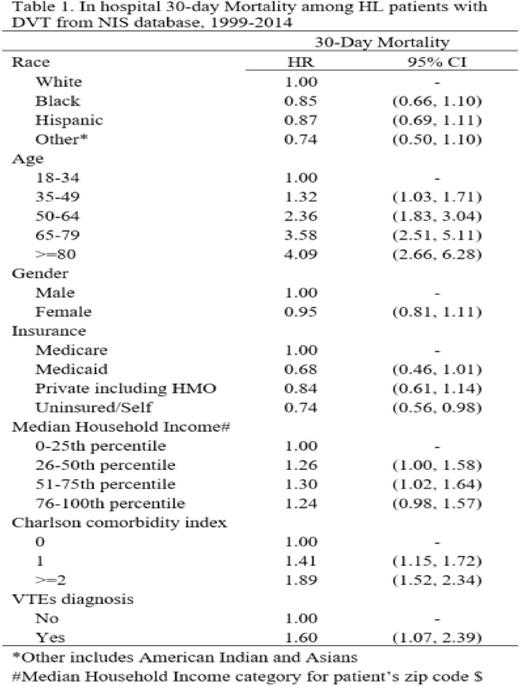Abstract
Background:
Venous thromboembolism (VTE) includes pulmonary embolism (PE) and deep venous thrombosis (DVT). VTE is associated with a large economic burden, as well as significant mortality and morbidity (LaMori et al. Clin Ther 2015, and Chew et al. Arch Intern Med 2006). Previous studies have suggested that Hodgkin's lymphoma (HL) is associated with risk of developing VTE (Mahajan et al. Thromb Res 2014). The mortality of VTE is increases significantly when it occurs in combination with other comorbidities such as cancer. We aimed to explore the risk of death and health costs in the admissions of HL with VTE compared to those admissions without VTE.
Methods:
We acquired the data from National Inpatient Sample (NIS) between the years 1999-2014 using the ICD-9 codes for HL( 2014, 2015, 2016, 2017, 2019) and VTE (45340, 45341, 45342, 45382, 45383, 41511, 41519). The primary diagnosis was HL and the secondary diagnosis was VTE. Chi-square analysis was used to determine the frequency distribution of various basic demographic characteristics like age, gender, race, primary insurance payer, income category, other comorbidities using Charlson comorbidity index. Cox proportional hazard analysis was performed to determine to the risk of death during the hospitalization among the admissions with VTE and without VTE.
Results:
The in-hospital mortality is significantly higher in the admissions with VTE compared to those without VTE. After controlling for age, gender, race, income, insurance status and comorbidities, the hazard of death during the hospitalization in the admissions with VTE was 59 percent higher than in the admissions without VTE (HR =1.59 , 95% CI 1.06-2.39, p=0.02). The cost of admissions with VTE was $ 113,223 ± 10,102, whereas the cost for those admissions without VTE was $ 65,784 ± 720 (p<0.001). The Length of stay in admissions without VTE was 9 ± 0.07 days whereas those with VTE was 13.1 ± 0.6 days (p<0.001).
Conclusions:
Based on the results from our study, the diagnosis of VTE HL patients is associated with significantly increased mortality, cost and length of hospitalization. Preventing VTE among patients with Hodgkin Lymphoma would be associated with decreased mortality. This can also significantly reduce the morbidity due to extended hospitalization and the cost per admission. Prospective studies are needed in this area to investigate the association between VTE and mortality, in-hospital cost, length of stay among and the effectiveness of antithrombotic prophylaxis among Hodgkin's Lymphoma patients.
No relevant conflicts of interest to declare.
Author notes
Asterisk with author names denotes non-ASH members.


This feature is available to Subscribers Only
Sign In or Create an Account Close Modal